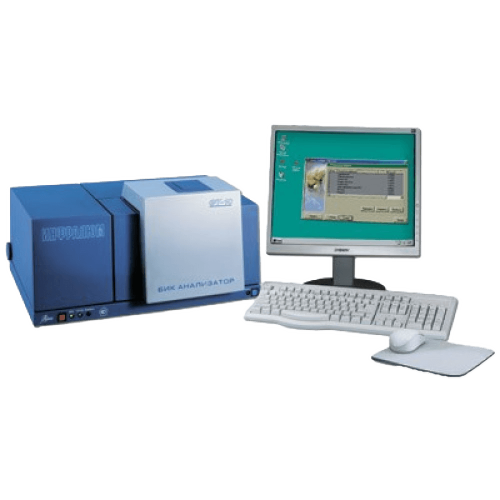Description
The price is for the base unit. To receive a commercial offer for the device in the working configuration, please contact the manager.
InfraLUM FT-12 infrared analyzer is a stationary laboratory device that can quickly determine the composition and quality of products such as wheat, barley, rye, oats, wheat and rye flour, corn, soybeans, soy flour, soybean meal, sunflower meal and oilseed meal, meat and bone meal, fish meal, fodder yeast, animal feed, milk powder, milk, yogurt, cottage cheese, cheeses, cheese masses, minced meat, etc.
Most types of samples are analyzed without preparation. Some solid, non-flowing samples (sunflower cake, soybean meal) or samples in highly absorbent casings (sunflower seeds) must be ground beforehand. “InfraLUM FT-12” is designed to simplify sample preparation as much as possible and increase the accuracy of analysis.
“InfraLUM FT-12” is based on the registration of absorption spectra using an efficient Fourier transform method. “InfraLUM FT-12” measures the spectrum at several hundred wavelengths. This significantly improves the accuracy of the analysis due to the larger volume and high accuracy of the processed information.
Distinctive features of the device:
- Simultaneous determination of all (including gluten) analyzed indicators in 1.5 minutes.
- The analysis is carried out with an error less than the requirements of GOSTs.
- Express analysis of grain is carried out without grinding – mills and grinding standardization are not needed for operation.
- Does not require reagents and consumables.
- Moisture and dustproof interferometer.
- Long lamp life.
- Possibility of organizing regional (corporate) networks with common calibrations.
- The possibility of expanding the list of analyzed objects and indicators, including remotely.
- Developed service throughout Russia and a number of CIS countries.
- Convenience and simplicity in work and service.
Software features:
SpectraLUM/Pro® program allows the user to change calibrations and develop own calibration models. When developing calibrations, the most modern mathematical models are used – the method of partial least squares (PLS), the method of principal component regression (PCR).
WORKING PROCEDURE
The analysis process looks like this: the operator places a cuvette with a sample into the instrument’s autosampler, selects the analysis program from the menu using a computer, and starts the measurement process. Further actions occur automatically.
The analysis results are displayed on a computer monitor. The operator can print the protocol or store the results in a database. The duration of the analysis is 1.5 minutes.
AREAS OF USE
- grain procurement: express determination of the grade and quality of grain and flour;
- poultry and livestock: control of the composition and quality of feed raw materials and feed;
- food industry: control of raw materials, products and waste, control of technological processes;
- veterinary control: control of the composition and quality of feed;
- sanitary control: control of the composition, identification and determination of the authenticity of products;
- chemistry and petrochemistry: determination of authenticity and identification of raw materials and products;
- pharmaceuticals: express identification of pharmaceuticals;
- Scientific research.
Areas of the greatest efficiency of the device:
- analysis in a limited time;
- analysis of a large number of components or samples with limited resources.
Specifications:
| Spectral range, cm-1 | from 8700 to 13200 | |||
| Spectral resolution, cm-1, no more | 10 | |||
| Limit of permissible value of the absolute error of the scale of wave numbers, cm-1 | ||||
| ±0,5 | ||||
| Signal-to-noise ratio determined in the range of ±100 cm-1 at a resolution of 16 cm-1 and an accumulation time of 60 s, not less than: | ||||
| Wave number, cm-1 | ||||
| 8900 3500 | ||||
| 10000 20000 | ||||
| 12500 6000 | ||||
| 13000 4000 | ||||
| The level of positive and negative pseudo-scattered light caused by the nonlinearity of the photoreceiving system (in relation to the maximum signal),%, no more | ±0,25 | |||
| Analyzer warm-up time, min, no more | 30 | |||
| Analyzer continuous operation time, h, not less than | 8 | |||
| Overall dimensions, mm, no more | 530x450x380 | |||
| Weight, kg, no more | 32 | |||
| Power analyzers from the AC mains: | ||||
| AC supply voltage, V | (220 ±22) | |||
| frequency Hz | (50 ±1) | |||
| Power consumption, V×A, no more | 110 | |||
| Mean time between failures, h, not less than | 2500 | |||
| Average analyzer service life, years, not less | 5 | |||
| Operating conditions of analyzers: | ||||
| ambient temperature, °C | from 5 to 40 | |||
| atmospheric pressure, kPa | from 84 to 106.7 | |||
| relative humidity at a temperature of 25 °С %, no more | 80 | |||



